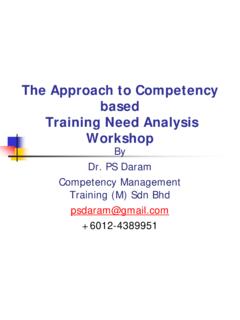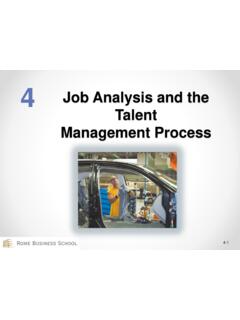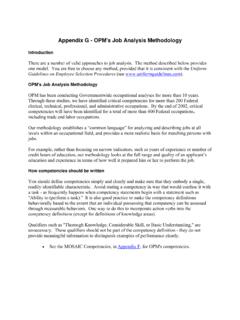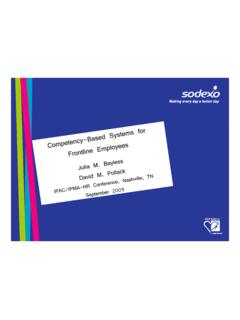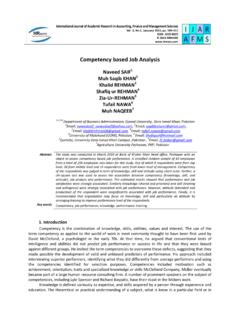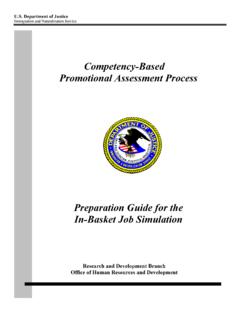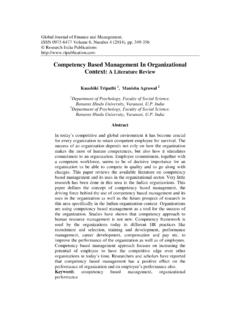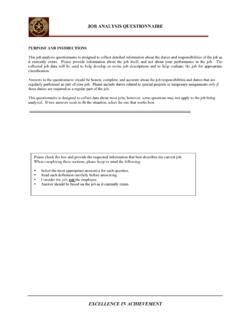Transcription of Competency Analysis Guide: Analysing and Verifying ...
1 2006 Copyright Working Futures Reproduction permitted for non-commercial, educational purposes. Page 1 Permission required for all other purposes. Contact Competency Analysis guide : Analysing and Verifying Training Needs in an Enterprise The Institute for Working Futures Pty. Ltd. December 2006 Purpose This document is a Competency Analysis guide provided to assist those undertaking Competency and capability Analysis as part of training needs or skills audit processes. This is a guide and can be tailored to suit the needs of an enterprise or can serve as a point of reflection for those engaged in defining how learning will support processes associated with assessment, position profiling, performance, and talent management. Context This Competency Analysis guide needs to be placed in context.
2 Analysis is one part of what can be a much larger process encompassing Competency - based training. Figure 1 below outlines this process and possible steps. This guide covers the first part of the four part ABII (Analyse, Build, Implement and Improvement process). Figure 1: The ABII design process1 The key activities within the Analyse phase is to preserve the strategic focus on: 1. Business need and outcomes 2. Reducing cost and time to competence 3. Suitability of interventions 4. Linkage of any intervention to the required skills, competencies (in all their forms and format) and/or capabilities 5. Promote qualification outcomes 6. Maintain linkages with overall governance processes 7. Avoid duplication and rework on either competencies or content designed to outcomes.
3 Contents PurposeContextA1 Identify Business Need A2 Profile Jobs and training required using the Competency dictionary A3 Confirm evidence requirements A4 Conduct needs Analysis A5 Confirm qualification linkages and funding modelOverall resources for the Analysis PhaseTool 1 Confirming business needs Icons This guide is prepared as a learning document with supporting information. The following icons are used to access further information on each topic. Tips Traps 1[1] Bowles, M (2003, revised 2007) Elearning Implementation Process Manual, Unitas Knowledge Centre: Sydney. 2006 Copyright Working Futures Reproduction permitted for non-commercial, educational purposes. Page 2 Permission required for all other purposes.
4 Contact The CBT Process Implementation of any learning or instructional strategy requires a systematic process. In any organisation it is essential this process be tied business outcomes, as well as learning outcomes. Conceptually the Competency - based training (CBT) design process for an enterprise can be based on the well established Systematic Curriculum and Instructional Development (SCID) process. This guide applies to the yellow shaded area shown below in the first part of the ABII process. Figure 2: The CBT Design Process 2006 Copyright Working Futures Reproduction permitted for non-commercial, educational purposes. Page 3 Permission required for all other purposes. Contact A1 Identify Business Need The Analysis Phase is vital as it drives well planned learning that delivers strategic value-add within a sustainable, continuously improvement process.
5 The impetus for the business need may include: 1. Response to business/HR drivers, include: Compliance/legislative need Improved employee satisfaction/value proposition Workforce/Job redesign Change imperatives New roles New hires Career planning Talent review Skill gaps New technology or processes Failure of existing training interventions 2. Assessed need, including via: Questionnaires Interviews (by trainer/ assessor with those doing the work) Interviews by peer or coach with those doing the work ( in a performance appraisal session) Unstructured interviews by manager with those doing the work Observation of those doing the work Records of performance Contrast the latest position descriptions and industrial agreement/ awards with Competency standards Assessment Centre for occupation/ group Expert data collection sessions Audits of team work for specific outcomes over time (See Attachment 1)
6 Use position descriptions, performance management tools, KPIs, Process Maps, quality systems, checklists, procedure manuals, diagnostic ratings, training programs, job Analysis forms, skills audits, occupational Analysis data, occupational and industry classification data, performance improvement targets award descriptions and such like to establish competencies at a level of work and equivalent Australian Qualification Framework level (or comparable national recognition system) Don t reinvent the wheel: Benchmark other companies and thoroughly check to see if the same problems/issues have been resolved successfully with a known approach or learning/content solution Remember that content that delivers performance and business improvement has an intellectual property value.
7 If properly accounted for this value can make training activity an investment in knowledge growth rather than a cost centre. Don t make Competency Analysis and training a solution for a problem related to other strategic or wider HR matters Not all content and existing learning will fit learning needs being identified. Often it is a mistake to try and force-fit legacy content and curriculum when new approaches are required. 2006 Copyright Working Futures Reproduction permitted for non-commercial, educational purposes. Page 4 Permission required for all other purposes. Contact A2 Profile Jobs and training required using the Competency dictionary The currency of the Competency Analysis and subsequent learning interventions must be detailed in the enterprises Competency dictionary.
8 There are many definitions or currencies for the learning and performance outcomes. It is strongly recommended that a capability- Competency lexicon used be done systematically. This may be a model provided by an academic or business consultant, or an approach adopted at a national or enterprise level. All learning, assessment and, in some cases, performance and talent management tools and content should be tied to a lexicon or dictionary of competencies. The more these are not recorded or lack consistency the greater the opportunity for duplication and increased costs, both in the development and future maintenance costs. Often companies have three main types of competencies One may be the scaled behavioural competencies or capabilities (about the values, traits, and/or the person and their behaviours, leadership capability and talent).
9 The second may be technical and functional competencies drawn from the national frameworks that are based on occupational standards (about the task performed to a standard required at a level of employment tied to the Australian Qualification Framework). The third set of descriptors may be simple skill statements. The process is as follows: 1. Mapping the competencies into the industry areas (business, mining, aviation, logistics and transport, etc), the occupation, job families, and, if possible, professional and functional groupings 2. Identify the level of work and comparable qualification level 3. Validate and access the capabilities and competencies on the enterprises dictionary ( Competency database) 4. If they are new or national Competency standards not on the Competency database source competencies off the national training information system (in Australia see the ) or import them using an agreed authoring and approval process 5.
10 Import leadership and management capabilities, national competencies and skills into a position 6. Where a Competency , skill or capability has a relationship with another descriptor ensure they are mapped and the relationship noted on the Competency database 7. Use the competencies to profile positions 8. Use the competencies to profile people When this process is completed for an area not previously mapped ensure the Using national Competency standards will promote the ability to credit Competency against formal qualifications that are internationally recognised. Training based on these competencies can often offset costs as government incentives and existing training recourses can be accessed. Some competencies can appear in different Training Packages.
